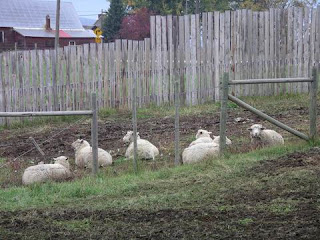







Yes they are back, sheep that is, on our land and in our ranching operation. A very big thank you to the Moilliet's of Aveley ranch for selling some of there Corriedale ewes to us. We picked them up on 7th November and ( another thank you to Frank, the livestock hauler) brought them home. It's 10 years ago this week that we sold the last of our pure bred Columbia sheep from our ranch in Manitoba and switched to cattle. We have not given up on cattle yet, but will play a wait and see game as to purchasing calves for grazing next year. I have mentioned in an earlier article that for some time now there has been too much politics, emotion and plain old fashioned price gouging and market control by the big boys in the cattle industry. So in our mind it is time for a species change and sheep are a natural fit here, also they are still my favorite. If all goes well this year with our ovine experiment we will buy in more ewes each year and build up a flock to graze the whole ranch. As for now we will stay on this side of the river, in the laboratory so to speak.
We arrived early at the Moilliet's to find they had the ewes already caught up for us to inspect, so after a once over , we said yes to them all, and retired for coffee, cake and a chat about sheep, the industry ,and folks we both knew so as to catch up on news and gossip. Frank the hauler arrived on time so we headed to the barn to load. They are some of the quietest sheep I have had the pleasure of owning and loading went smoothly, as it was a tight fit we picked some of the smaller, lighter ewes up and placed them in the nose cone. Getting them out was fun as I slid them down a sheet of plywood, see photo. The flock traveled well and unloading went smoothly and all ewes arrived in good shape. We gave them access to the river for water and some hay , and kept them in the corrals over night so as to observe them in case of any problems.
The next day we let them out to graze were they met our 7 Dorset cross ewe lambs and Seamus and Tyrone our two Dorset rams.They all are getting along well,if you know what I mean , so we should have lambs next April. The whole flock follows easily as you can see by the pictures so it should be a snap next year when we move for rotational grazing. We are nearly out of grass now so I will start feeding the baled silage in the next few days, this will be a learning curve for me and the sheep so I will save that for the next article.






















































